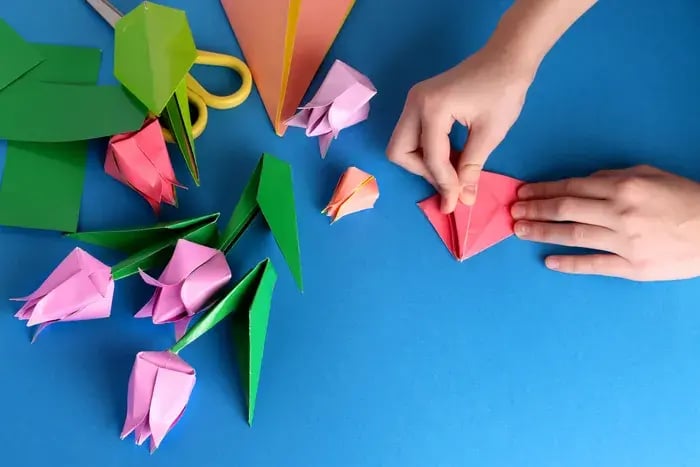- Fine motor skills
- Improves Concentration and Patience
- Develops Problem-Solving Skills
- Boosts Creativity and Imagination
- Encourages Cultural Appreciation
Introduction
Kids love to create, and origami is an excellent method to keep their hands busy while developing their attention and patience. Though it might appear easy, folding paper into lovely forms calls for meticulous attention to precisely every aspect. Origami enhances problem-solving capacity as well as fine motor skills, and it also inspires creativity. These enjoyable paper-folding projects enable kids to have fun while building important skills, whether at home or at school. Here are some easy origami craft projects that teach patience, concentration, and precision for kids’ learning development.
Origami Butterfly
This simple origami project introduces a child to the elements of symmetry and precision. Step-by-step folding results in beautiful butterflies. It makes kids understand the concept of spatial reasoning, refine their instruction following ability, and stimulates creativity as each one can design butterflies with colored paper and add as much detail and patterns as they like.
Origami Boat

Origami is so cool, starting with the traditional paper boat for beginners. It will help develop patience and further hone the accuracy in making sharp, crisp folds. It's a fun educational project that lets the child play around with simple geometric concepts. Let the kid float his paper boats in the water to enhance the interactive aspect of the activity.
Origami Crane
Another of the most popular origami models, the crane requires that a child maintain focused folds and layered steps. The creation of an origami crane improves hand-eye coordination, trains concentration, and fosters perseverance. In addition, it enables the children to be exposed to the Japanese culture and the historical significance of this iconic figure.
Origami Frog
It's a fun project, the origami frog which involves making folds that make it "jump" when pressed, teaching the concept of symmetry, measurement, and movement. Also, this promotes fine motor skills and problem-solving as kids readjust folds to make the frog leap higher.
Origami Star
Perfect for festivals or decorations, an origami star teaches children patience and precision. This project helps refine folding techniques, improving finger movement and focus. Children also learn about geometric shapes and symmetry as they carefully craft each point of the star.
Origami Heart
An easy yet meaningful project, folding an origami heart is a great way to introduce kids to structured folding patterns. It helps build fine motor coordination, patience, and accuracy. Kids can write messages on their hearts or use them as creative gifts for loved ones.
Origami Tulip
This is how folding a tulip could be used to instruct a child about shaping paper to represent natural forms. The activity helps the child to understand proper hand movement, proportion, and development of creativity. Kids can experiment with all colors to produce an origami flower garden.
5 Advantages of Origami for Children
Fine motor skills
Origami demands accurate movements of fingers, thus developing muscles within hands and improving movement. Repeated folding motions enhance hand-eye coordination, which gets children ready for writing and drawing.
Improves Concentration and Patience

To fold paper to a shape takes patience. Kids learn to read out steps carefully and pay attention as well as learn to work through challenges with minimal frustration.
Develops Problem-Solving Skills
Origami teaches kids how to analyze instructions and find solutions. If a fold is incorrect, they must fix and adjust their approach, helping to build critical thinking and problem-solving abilities.
Boosts Creativity and Imagination
With origami, kids can explore endless creative possibilities. They can modify designs, experiment with colors, and even invent their own folding techniques, fostering artistic expression and innovation.
Encourages Cultural Appreciation

Origami introduces children to Japanese culture and traditions. Learning about the origins of paper folding broadens their understanding of global art forms and historical practices, making learning more enriching.
Deepali Verma is a senior food and wellness writer with over a decade of experience in top media houses, crafting engaging narratives. She is a professional home baker and loves exploring food from every corner of the world to reading cookbooks. She believes a healthy lifestyle is a combination of mental, spiritual and physical fitness. Her goal always remains to keep moving, eating seasonal and practicing gratitude.
The views expressed are that of the expert alone.
References
https://kidminds.org/origami-projects-for-kids/
https://momlovesbest.com/origami-for-kids
The information provided in this content is for informational purposes only and should not be considered a substitute for professional medical advice, diagnosis, or treatment. Always seek the advice of your physician or another qualified healthcare provider before making any significant changes to your diet, exercise, or medication routines.










